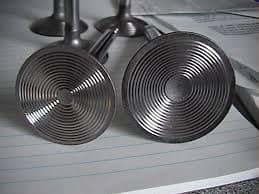Surface Turbulence
#1
Surface Turbulence

Was wondering if anyone has done this in our cars and if you think it's worth it?
ST valves (Surface Turbulence) improve fuel economy, reduce emissions and detonation and facilitate easy tuning. Surface turbulence looks like concentric grooves machined into the head of the valves.
Last edited by Fuego; Nov 15, 2016 at 03:09 PM. Reason: To much info
#3
Lol no koolaid. It's actually a shop that works on BMWs.
http://metricmechanic.com/
maybe I posted to much but I don't care about the springs or the valve guide they use because it's a different car, just the valve surface turbulence is what I'm interested in
http://metricmechanic.com/
maybe I posted to much but I don't care about the springs or the valve guide they use because it's a different car, just the valve surface turbulence is what I'm interested in
Last edited by Fuego; Nov 15, 2016 at 03:04 PM.
#4
ST Intake Valve
Controlled turbulence can enhance airflow. This happens because turbulence helps eliminate the "boundary layer", the dormant layer of air in direct contact with the valve's surface. To create this turbulence, we machined a series of concentric grooves on the backside of the intake valve. By way of trial and error, we altered the size, shape and number of grooves until we came up with an optimal flow increase. The grooves "stair step" up the valve head like small ramps. This changes the characteristics of the boundary layer as it flows over the intake valve. Instead of air dragging, it now tumbles over the surface of the valve - like a layer of tiny spinning ball bearings. Over such a surface, the main stream can now move at full speed. Also, as air flows over these ramps, the fuel mixture hits the backside of the valve and is kept homogeneous by the tumbling that the grooves generate. Having fewer heavy particles, the homogeneous mixture burns more completely. So, the effect is that the "boundary layer" which is normally lost in airflow with a conventional valve, now has an airflow gain of 2% - 4% by using the ST Valve
They take the OEM and other brand Valve and at the ST to them. I emailed them to see what they tell me.
Controlled turbulence can enhance airflow. This happens because turbulence helps eliminate the "boundary layer", the dormant layer of air in direct contact with the valve's surface. To create this turbulence, we machined a series of concentric grooves on the backside of the intake valve. By way of trial and error, we altered the size, shape and number of grooves until we came up with an optimal flow increase. The grooves "stair step" up the valve head like small ramps. This changes the characteristics of the boundary layer as it flows over the intake valve. Instead of air dragging, it now tumbles over the surface of the valve - like a layer of tiny spinning ball bearings. Over such a surface, the main stream can now move at full speed. Also, as air flows over these ramps, the fuel mixture hits the backside of the valve and is kept homogeneous by the tumbling that the grooves generate. Having fewer heavy particles, the homogeneous mixture burns more completely. So, the effect is that the "boundary layer" which is normally lost in airflow with a conventional valve, now has an airflow gain of 2% - 4% by using the ST Valve
They take the OEM and other brand Valve and at the ST to them. I emailed them to see what they tell me.
Thread
Thread Starter
Forum
Replies
Last Post
QAT-R
Automotosports - Illinois
3
Sep 17, 2006 08:56 PM



